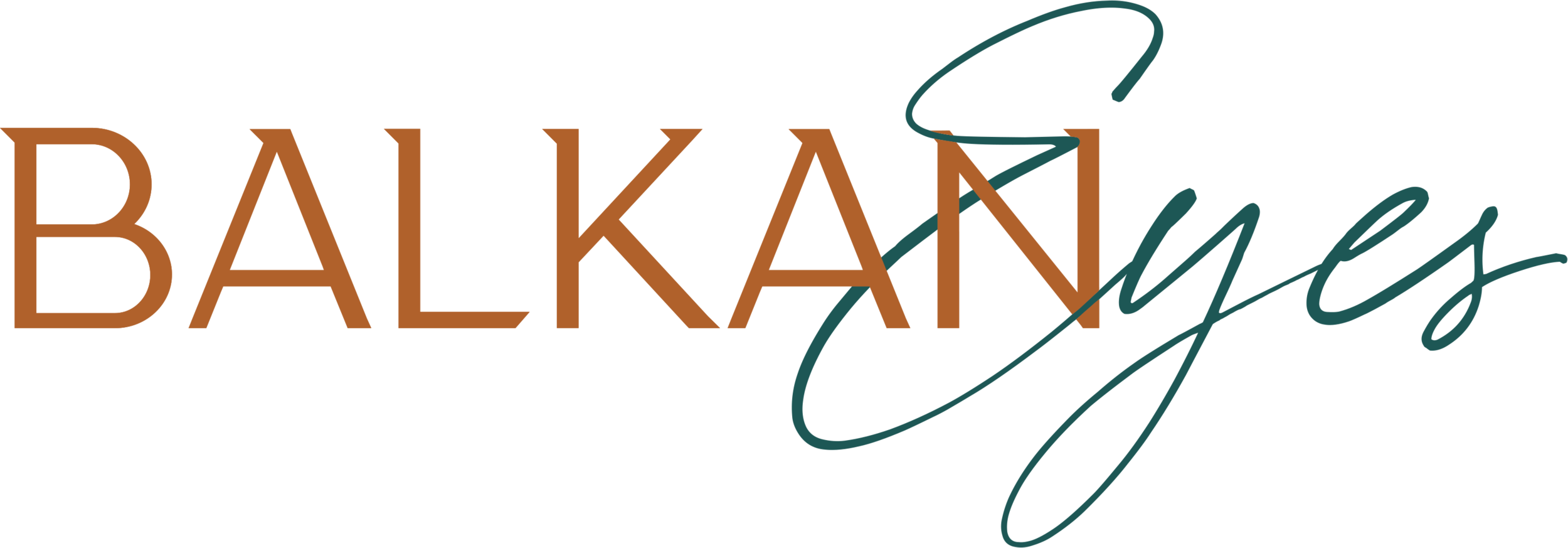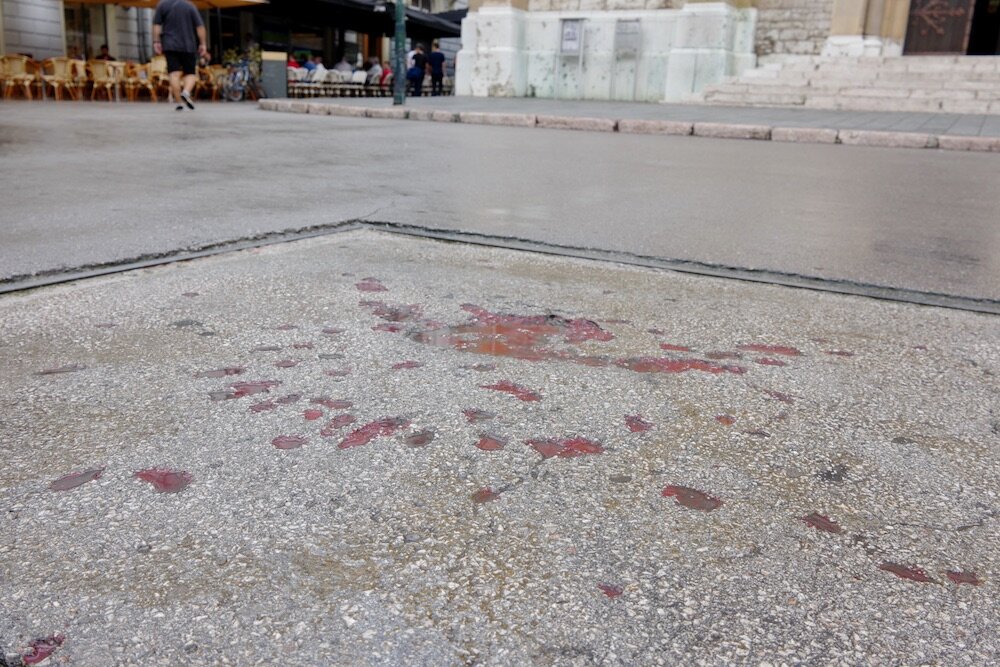The 1972 film Walter Defends Sarajevo tells the story of Walter, a real-life resistance leader against Nazi occupation who masked his identity to infiltrate the Nazis. In the last scene, two Nazis walk along a hillside overlooking Sarajevo as one reveals that he has finally uncovered the identity of Walter. When the other demands to know Walter’s identity, he reverently responds, “Do you see this city?” as the camera pans over Sarajevo, “This is Walter.”
Fifty years later Sarajevo found itself in the middle of another war that became the longest siege of a capital city in modern history. To symbolize their unity and endurance, Sarajevans chanted “We are Walter” in protest of the conflict.
For most of its history, Bosnia was a subject of successive empires that each left its mark on Sarajevo. The city tells you this story as you walk its streets beginning in the Old Town’s Baščaršija bazaar.
Turkish influence from hundreds of years of Ottoman rule is imparted in the oxidized copper domed roofs, the minarets that jet into the skyline next to slavic orthodox churches, and burek pastry warming in windowsills. This area of town is where Sarajevans can come to relax at the outdoor cafés, sip Turkish coffee, and smoke hookah.
After walking about five minutes past the Gazi Husrev-beg’s Mosque and the bazaar shops selling art, clothing, and souvenirs, the narrow street widens into a European boulevard and the short wooden buildings flow into taller buildings with decorative embellishments and pastel colors reminiscent of Bosnia’s period under the Austro-Hungarian Empire. Two blocks towards the river you will find the Latin Bridge where a young Bosnian nationalist assassinated Archduke Franz Ferdinand bringing an end to Austro-Hungarian rule and the start of World War I.
The pedestrian-only boulevard full of restaurants and shops merges into Maršala Tita street, named after Josip Broz Tito, the unshakable and unifying ruler of Yugoslavia until his death in 1980. Along Tito’s street the decorative architecture flattens into the stark style of communist times when the preferred material was cement and the façades had no frills, just utility.
In all areas of the city, the indentations from mortar and artillery shells in buildings and sidewalks are reminders of the Sarajevo that continues to rebuild. While walking through its streets, you can feel that Sarajevo is a city that has adapted to survive.
Sarajevo City Hall was destroyed by artillery in 1992. It was restored to its original specifications and reopened in May 2014.
As of the 1991 census, a little over half a million people lived in Sarajevo of whom 49% were Bosnian Muslims, 30% were Bosnian Serbs, and 7% were Bosnian Croats. [1] Before the conflict, citizens of Sarajevo referred to themselves not by their ethnic groups, but simply as Sarajevans. [2]
By mid-1992, shelling in the city escalated to the point where normal life ceased: the cable car to Mt. Trebević and the tram connecting the eastern and western sides of the city stopped operating; there were shortages of food, medicine, and other essentials; and the city’s ethnic pluralism was divided by the front lines that separated Bosnian Muslims from Bosnian Serbs. [3]
On May 6, 1993, the United Nations (UN) Security Council declared Sarajevo as a safe area, along with Tuzla, Žepa, Goražde, Bihać, and Srebrenica. The UN resolution also provided for an immediate cease-fire and declared the safe areas to be free from armed attack by all parties and any other hostile acts.[4] These words had little to no impact on day-to-day life in Sarajevo.
Designation as a “safe area” entitled Sarajevo to humanitarian aid from the UN. However, delivery of this aid was contingent on landing aircraft at the Bosnian Serb-controlled airport and driving the aid to the city on Bosnian Serb-controlled roads. By July 1995, the UN Protection Force reported that civilians in Sarajevo were surviving on whatever food they had stockpiled, on what they could grow in vegetable gardens, and whatever goods were smuggled into Sarajevo through a tunnel that was dug from the edge of Sarajevo to the airport. [5]
View of Sarajevo from abandoned building on Mt. Trebević.
Throughout the siege, Sarajevans risked falling into the crosshairs of a sniper’s rifle or the target zone of artillery shells any time they walked out their front door. The targeting of civilians was indiscriminate. Snipers and other artillery fired at the young and old, men and women, and people sitting on trams, waiting in line for water, and walking to school.
In early February 1994, a mortar shell exploded at Markale market in the center of Sarajevo, killing at least 66 and wounding around 200 others. [6] On December 1994, a shelling incident took place in Baščaršija in the Old Town. [7]
In April 1993, a nine-year old girl was shot in the back while playing in her front yard. When her neighbors pulled away in their car to take her to the hospital, the sniper fired at their car. [8] In March 1995, a fourteen-year old boy was shot while walking home from school just after passing through a covered area that allowed people to get around while protected from sniper fire. Snipers, indifferent to the identity of their victims, shot at whomever exited the covered alleyway next. [9]
A Sarajevo “Rose” made by filling dents in the pavement left by a mortar shell explosion with red resin.
Both sides in the conflict used sniper fire. At criminal trials prosecuting charges based on sniper fire, the prosecution had to establish the direction of the sniper fire to prove which side fired the shot or was likely to have fired the shot based on known sniper outposts. The perpetrator was not always evident and neither was the victim.
The Oscar-winning film No Man’s Land, which teeters the line between comedy and tragedy to depict the absurdity of the Bosnian conflict, illustrates the difficulty of identifying the enemy and victims. In one scene, a Bosnian Muslim solider and a Bosnian Serb soldier find themselves hiding in a bunker together unable to identify whether they are enemies or allies and dodging fire from a shooter who does not know whether he is firing at one of his own and does not appear to care.
In 1995, the balance of power around Bosnia shifted against the Bosnian Serbs. In large part because of support from foreign governments, the Bosnian Federation Army was able to attack with greater strength and better equipment. [10] A cease-fire in Sarajevo was agreed upon on 12 October, 1995 and the fighting ended shortly after.
A demographic expert, who testified at trial, concluded that between April 1992 and November 1995, a minimum of 952 civilians in Sarajevo died as a result of sniper fire or war-related causes, and another 2,292 were wounded due to sniping. [11]
A majority of Sarajevo is located within the Federation of Bosnia and Herzegovina; however, if you drive just around Mt. Trebević to the south or on the highway exiting Sarajevo to the north, you will quickly see signs welcoming you to Republika Srpska.
Travel Tips:
Bobsled Track.
The 1984 Olympic bobsled track is a highlight in Sarajevo and embodies the rise and fall of Yugoslavia. The easiest way to get to the bobsled track is to take the cable car to the top of Mt. Trebević and to walk about 150 feet down the path below the tram station to the start of the bobsled track.
Another option is to take a taxi. If you plan on driving a rental car, set your navigation app to go to Pino Natur hotel, but ensure your app takes you on road R446 past Sunnyland amusement park. This is a longer route from Sarajevo, but the road is better. The narrow and steep roads up the face of Mt. Trebević are nearly impossible to maneuver. Take a left turn on the road just before reaching Pino Natur hotel that is marked with piece of the bobsled track and a small parking lot on the left side where the road is located. You can either park in this lot and continue walking about ten minutes down the road to the bobsled track or you can drive to the track. A paved road follows the entire length of the track.
Hiking up roads or trails to the bobsled track is not advised. The roads can be difficult to navigate and there are many unfriendly dogs on these roads who act as gatekeepers.
Another Olympic site is the ski jump located at Mt. Igman about 45 minutes outside Sarajevo. You will need to rent a car to get there and Google maps has accurate directions to the destination “Igman Olympic Jumps.”
1984 Olympic bobsled track that was used by the Bosnian Serb army as an artillery position
Museums.
Galerija 11/07/95. This is a photo gallery dedicated to the victims of the Srebrenica genocide. It is powerful and highly recommended, particularly prior to a day-trip to Srebrenica. The museum is located in the Old Town by the Cathedral of Jesus’ Heart. Address: Trg Fra Grge Martića 2/III, Sarajevo
City Hall. This stunning building, which served as City Hall and the National Library, was built during the Austro-Hungarian period and was destroyed during the conflict. Restoration finished in only 2014. The atrium features intricate moorish design and stained glass and is definitely worth a visit. A museum in the bottom level of the building goes through extensive history of Sarajevo. Address: Brodac 1, Sarajevo
Museum of the Jews of Bosnia and Herzegovina. This museum is located in the oldest Synagogue in Bosnia built in 1581 in the Old Town. It tells the history of the large Jewish population in Sarajevo prior to WWII and the rise of anti-Semitism and extermination of the Jews during WWII. Address: Velika avlija bb, Sarajevo.
Museum of Crimes Against Humanity and Genocide. This museum displays information, photos, and items related to the extent of the crimes committed in the 1990s in the region. The topics of this museum are dark but important to preserve the memory of what happened. Address: Muvekita 11/1, Sarajevo
Walter Defends Sarajevo Museum. You can watch Walter Defends Sarajevo at the museum devoted to the film. This is a small museum - and may not be worth the trip if you watch the film on your own but makes a good rainy-day activity. The museum is located in the Old Town near the Markale Market. Address: Dženetića Čikma 12, Sarajevo






